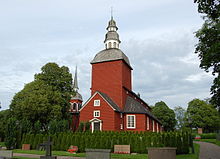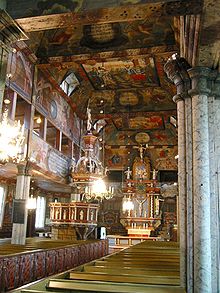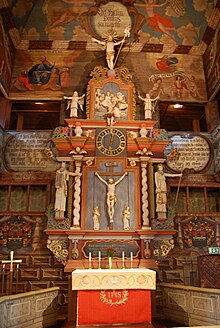Habo Church
The Habo Church is the Church of Sweden is part of Church in Sweden Habo in Småland . The wooden church , built in the form of a basilica , is known for its extensive decoration with wall and ceiling paintings. It is located about five kilometers southwest of the village.
Architecture and history
middle Ages
A first church was probably built in Habo in the 12th century, after missionaries came to the region as early as the 11th century. Consisting of sandstone made baptismal font dates back to the 13th century. The altar , which dates from the 14th century, is also significantly older than many parts of the church furnishings . During a renovation in 1716, a reliquary was found in the altar . Inside was a parchment with a note that Bishop Sigge consecrated the altar in the middle of the 14th century. The oldest part of the church is the medieval sacristy , which is also the only part made of stone. There are other objects from the Middle Ages, including ten wooden images of saints and the iron door to the sacristy. Noteworthy is a large wooden sculpture of John the Baptist holding a lamb , which was made in the 13th century. Other smaller figures date from the 15th century and were part of the former altarpiece.
The church was rebuilt several times. Lateral extensions were added to an old long church, so that a cruciform church was created. This is how Habo Church is depicted on a seal from 1622. After that the church had two small towers on the sides in addition to a large steeple. In 1680 another renovation took place in which the church was expanded to the west.
Remodeling in 1723
In 1704 the provost Martinus Seth became pastor of the church. Those interested in building technology advertised that the church should be rebuilt. Presumably he also made architectural drawings himself. With his proposal, he encountered resistance, as the construction required considerable expenditure from the community members, but was ultimately able to prevail. In 1723 the church of Habo was given its present form through this reconstruction. Unusually the church in the shape of a cathedral was built of wood. Like a basilica , the church has a high central nave and two lower aisles. The size of the church was based on the considerable size of the congregation, with 2000 parishioners. On the left side of the choir is a plaque commemorating Martinus Seth. There is a corresponding sign for the builder Sven Nilsson Swan on the right.
In the course of the renovation, the church also received the pulpit that is still present today. The pulpit is surrounded by the twelve apostles. Jesus is in their midst. On the pulpit is the figure of the Grim Reaper , who embodies death, but who is lower than the figure of Jesus on the altarpiece. The pulpit and altarpiece were created by Jonas Ullberg , a sculptor from Härja .
The altarpiece depicting the crucifixion of Jesus, his burial and the resurrection was also made in 1723. A figure of the risen Jesus stands at the top of the altar wall with a victory flag. To the left and right of the altarpiece are Moses with the stone tablets and to the right his brother Aaron with a green stick. The clock that was added later is unusual in the altarpiece. It was built in Jönköping in 1750 , its clockwork constantly fills the church with a quiet ticking. Every hour on the hour, a figure of a boy sitting above the clock strikes two hemispheres with a hammer. The clock has only one hour hand .
In the church women and men sat separately. The women sat on the left, the so-called spinning side, and the men on the right, the sword side. The landowners used the manorial chairs in the boxes to the left and right of the altar and also had a separate entrance to the church. Below the organ is the Fronbauernempore, which was used by the small farmers at the rectory. Otherwise, the farmers and especially the smallholders were entitled to the rear seats. Maidservants and servants sat in the galleries .
1736 Haboer sculptor created Magnus Johansson Ullberg- existing today organ . The organ at that time was created by Johan Niclas Cahman and had eight voices . In 1962, however, a new organ built by Olof Hammarberg had to be purchased. The restored pipes , however, still come from the Cahman organ. This new organ has 16 parts and is made in the Baroque style.
Decorated with paintings from 1741 to 1743
Between 1741 and 1743, Johan Kinnerus and Johan Christian Peterson carried out the extensive painting of the church that is still preserved today. The representations reflect Luther's catechism , which was supposed to be learned by heart at the time. The pictures served as support and were probably an idea of the pastor. In some cases there are also written declarations. Pictures dealing with the Ten Commandments are on the side walls, the even commandments are on the left, the odd ones on the right. The Lord's Prayer is depicted above the galleries, starting to the left of the altar. According to legend, while working on the picture for the text line But deliver us from the evil, the devil appeared to the painter. The picture is to the left of the pulpit, very high up below the window. The devil climbed the ladder to the painter and complained that he was not as ugly as portrayed by the painter. As a punishment, the painter should become even uglier. The devil is said to have pushed the painter off the ladder, who injured his face in the process.
The theme of the creed is on the ceilings of the galleries, with an apostle on each picture. Women are depicted in the area of the organ. This could be the Swedish Queen Ulrika Eleonora . The painters used colors that they obtained from metal oxides as well as plants and earth.
In addition to the already mentioned memorial plaques for Seth and Swan, other memorial plaques were also attached. Below the representation of the fifth commandment is a plaque commemorating the victory over Russia in the battle of Narva in 1700. Also on the right-hand side under the third commandment is the epitaph for the sculptor Magnus Ullberg-Johansson. Another plaque on the left contains an invitation from Friedrich I and Ulrika Eleonora to celebrate the Augsburg Confession .
The mighty-looking church tower is more of a structural ornament and does not have bells. For the bells, a separate bell tower was built northeast of the church in 1760. Two large bells date from the 16th century, albeit cast. A smaller bell was cast in Jönköping in 1760.
The first damage to the pictures was reported as early as 1776. Further damage was caused by the stoves that were used to heat the church in the past. The pictures for the third and fourth commandments were particularly affected.
In 1872 the church was restored.
In 1908 the church was restored and the seating was renewed, with the doors of the old pews being used as paneling on the side walls. Today the church can accommodate around 600 visitors. During this restoration, a new baptismal font was also purchased. The old baptismal font was in a shed and was forgotten. It has long served as a mortar for mixing red paint. It was not until 1951 that the old baptismal font was used again for its original purpose. Traces of red paint can still be found on the inside of the baptismal font. In 1912 pictures were restored.
In 1952, pictures were again repaired, but also cleaned and saved. An overpainting of the pictures, as is often the case in other churches, was never done in the church of Habo. In 1981 a small organ, also built by the Gothenburg organ builder Olof Hammarberg, was installed in the choir.
literature
- Karin Bodin: Habo Church - a description in words and pictures. 1995.
Web links
Coordinates: 57 ° 53 ′ 7.4 ″ N , 14 ° 1 ′ 15.1 ″ E





